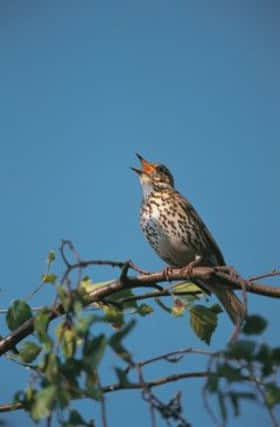Birdwatch: Winter mornings alive with sound


Some thrushes were singing before Christmas, now more are being heard on sunny mornings.
The one that always reminds me that spring is not too far away is that of the song thrush, a few loud clear phrases repeated two or three times which will continue to be heard, unless the weather takes a turn for the worse, until July.
Advertisement
Hide AdAdvertisement
Hide AdThe mistle thrush’s song, one of the furthest carrying of any British bird, is ringing from the highest trees or rooftops.
Robins have sung throughout winter, especially where there’s bright street lighting but now, as they increase their efforts to defend their territories, the song grows richer while wrens, mostly silent until now, are starting to deliver their loud passionate bursts of song again.
Dunnocks can also be heard, a thin little warble, and the first male chaffinches might be singing towards the end of this month.
One or two of the increasing numbers of overwintering chiffchaffs in the region have been singing on sunny mornings, perhaps early attempts to establish territories before the return of chiffchaffs that have wintered around the Mediterranean.
Advertisement
Hide AdAdvertisement
Hide AdAnother bird that has benefitted from the mild winter is the bearded tit with large numbers in the redbuds on the Blacktoft Sands reserve near Goole.
They are now being seen all around the reserve, sometimes at close quarters alongside footpaths near the Singleton hide or along the ditch near the visitor centre.
The New Year got off to an excellent start with a little bustard found on New Year’s Eve in a kale field at Fraisthorpe south of Bridlington and which was still present on New Year’s Day giving large numbers of birders the chance to see it.
There have only been about 25 previous UK records since 1950 including one just down the coast from Fraisthorpe at Aldbrough in November 1956.
Advertisement
Hide AdAdvertisement
Hide AdMore glaucous and Iceland gulls have been turning up in gull roosts including an adult Kumlien’s gull, a race of Iceland, in the roost at Wheldrake Ings near York for the third consecutive winter. There have also been two Iceland and a glaucous gull there. Up to 90 whooper swans and at least one Bewick’s swan are on the Lower Derwent Valley reserve at North Duffield Carrs. Six Bewick’s, four adults and two juveniles, were seen at Swinefleet near Goole.
A black redstart was seen on the settling lagoons at Horbury sewage works, West Yorkshire.
Long stayers include the Blyth’s pipit at the Calder business park, Wakefield and great northern diver at Mixenden reservoir, Halifax.
An illustrated talk on the wildlife of Estonia, organised by the High Batts Nature Reserve will be held at Bishop Monkton Village Hall on January 13 at 7.30pm. Speakers are Marika Mann, founder of Estonian Nature Tours and Tarvo Valker, one of the country’s leading birdwatchers. Tickets are £2.50. For more details, call 01765 604220.